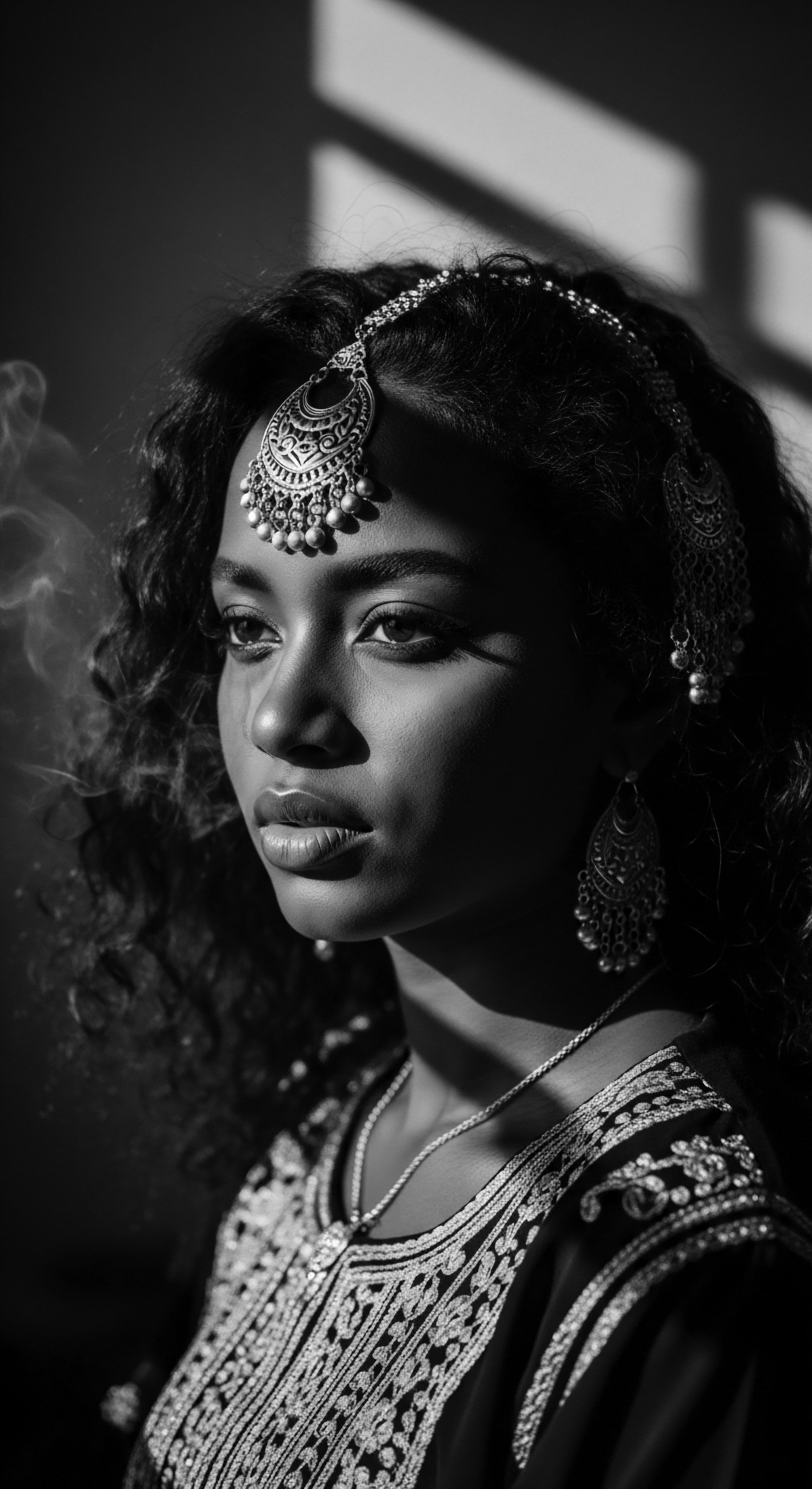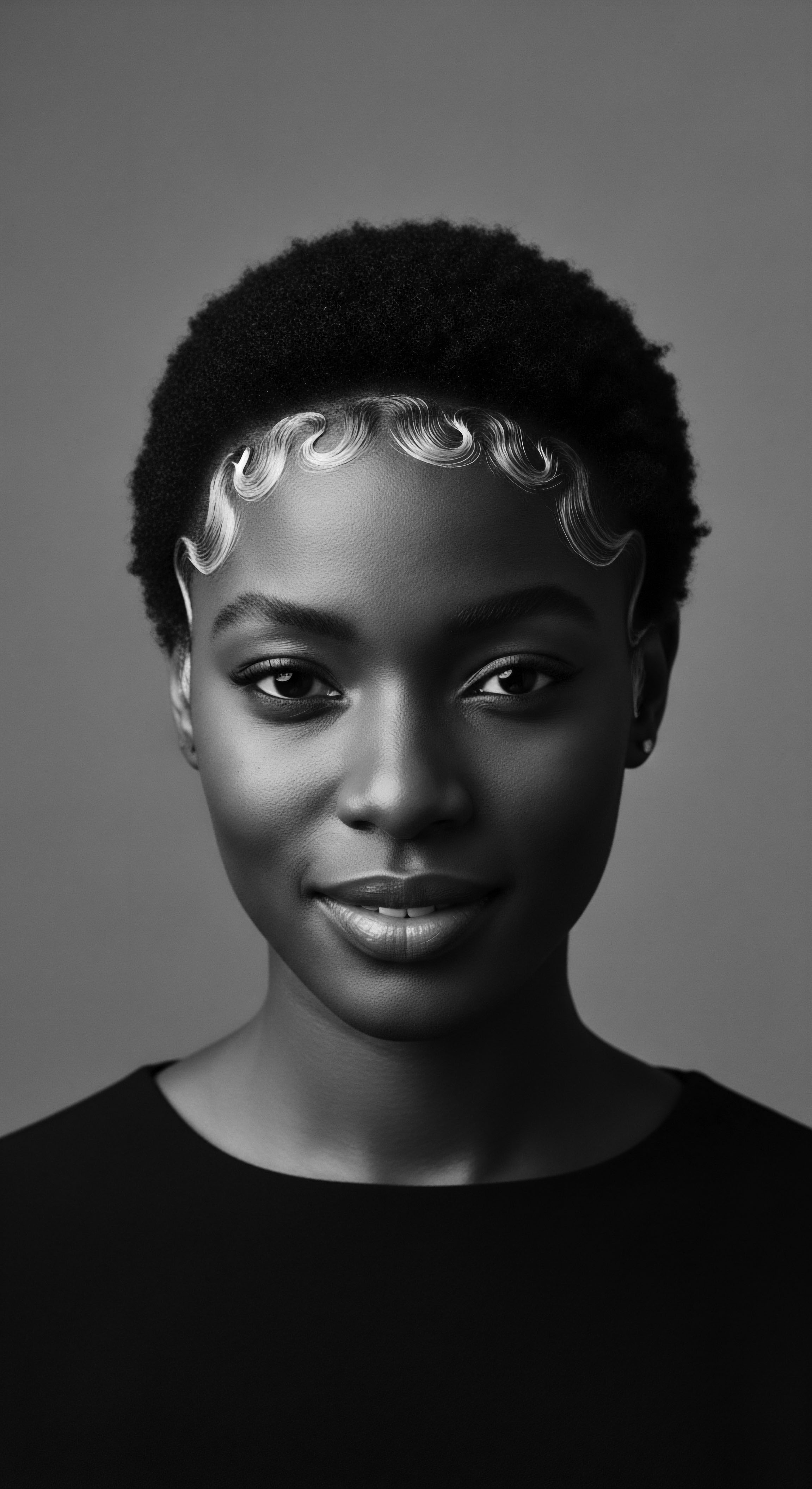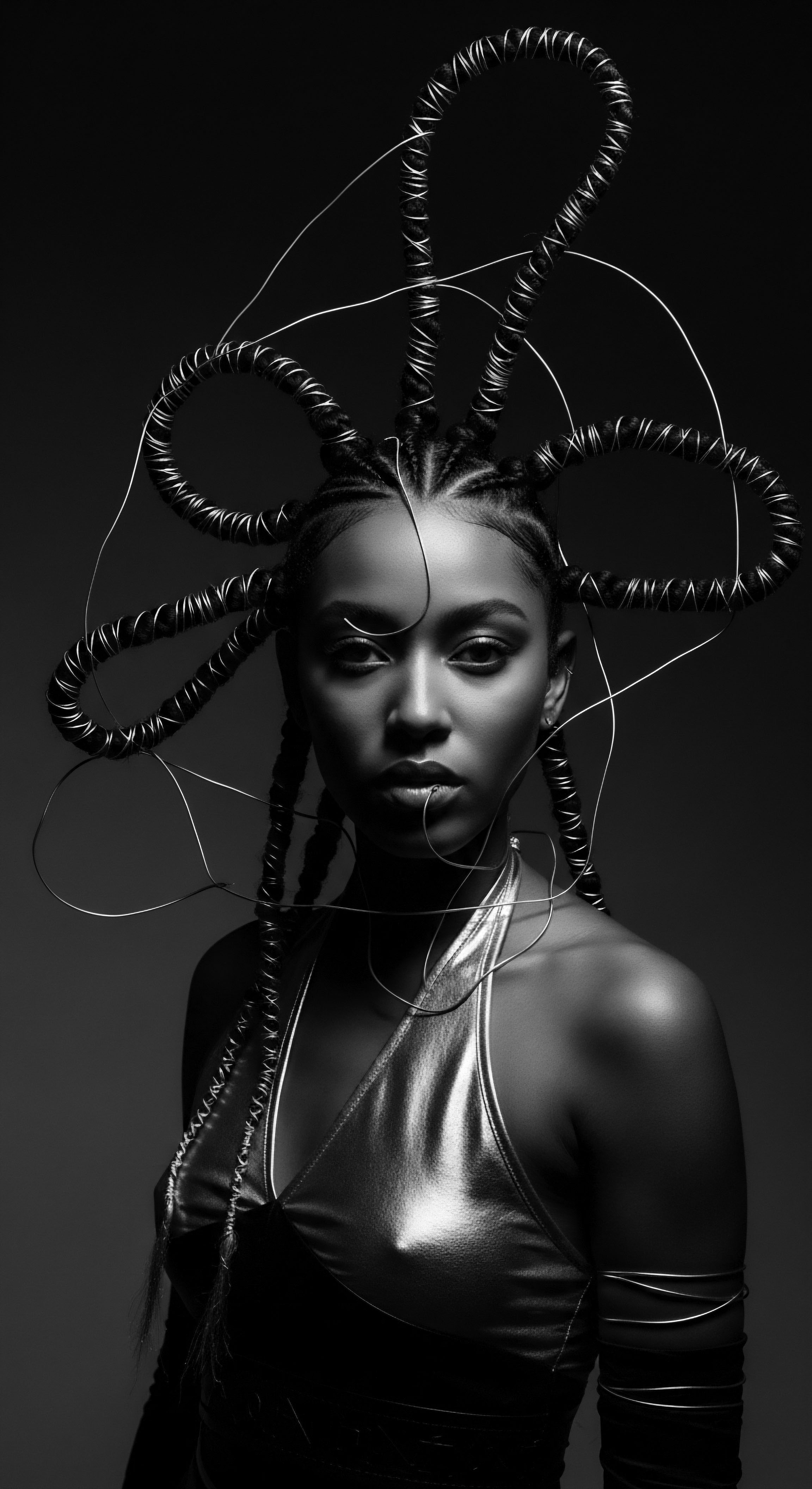
Roots
The coil, the kink, the curl—each strand a testament to ancestral legacies, a living archive whispered across generations. When we speak of textured hair, we speak of more than mere biological structure; we address a profound connection to identity, a continuum of care that stretches back to communal rituals under African skies. The hot comb, seemingly a simple tool of transformation, enters this deep lineage not as an isolated implement, but as a complex character in the evolving story of Black and mixed-race hair heritage. Its presence, its very rise to prominence, speaks to shifting landscapes of belonging, resistance, and the enduring quest for self-expression.
Consider the inherent architecture of textured hair. Unlike its straighter counterparts, afro-textured hair possesses an elliptical cross-section and a unique helical structure, a spiral form that dictates its volume, strength, and propensity for intricate patterns. These attributes, while celebrated in traditional African cultures, faced significant pressure in diasporic contexts, particularly after forced migration. Enslavement efforts included the deliberate act of hair removal, a brutal severing of cultural ties and individual identity.
During mass enslavement and transport to the Americas, slaveholders often cut the hair of both men and women, aiming to objectify and erase the styling culture passed through generations. This deliberate erasure set the stage for later anxieties around hair, where the aesthetics of European hair became the measure of acceptability, impacting everything from social standing to economic prospects.
The story of the hot comb is inextricably woven into the larger tapestry of textured hair heritage, reflecting societal pressures and profound acts of self-definition.
The very lexicon surrounding textured hair has carried the weight of this history. Terms like “good hair” or “bad hair” emerged as cruel echoes of racial hierarchies, often assigning higher value to hair textures that more closely resembled European types. This systemic bias created a demand for tools and techniques that could alter natural texture, offering an often illusory path to integration. The hot comb, initially developed in France in the late 19th century by figures like Marcel Grateau for a wider audience, found a specific and powerful purpose within the African American community.
Its design, especially the modifications made by early Black beauty pioneers like Annie Malone and later popularized by Madam C.J. Walker, with wider teeth, allowed for more effective straightening of tightly coiled strands.

Anatomy of the Strand And Ancestral Wisdom
Each strand of textured hair, from its elliptical root to its delicate tip, carries a legacy. The cuticle, the outermost layer of the hair shaft, with its overlapping scales, influences how moisture enters and leaves the hair. In textured hair, these scales may naturally be more open or raised, contributing to porosity. Understanding this fundamental biology helps explain why heat styling, without proper care, can cause significant alterations.
A study highlighted that routine practices, including heat styling, cause significant changes in hair’s water permeability, surface topography, and appearance, reducing mechanical and thermal properties. Ancestral care rituals, long before the hot comb, instinctively addressed these needs through the use of natural butters, herbs, and oils, sealing moisture and maintaining the hair’s integrity.
The introduction of the hot comb, therefore, was a technical answer to a complex cultural yearning, a tool that provided a temporary alteration to hair’s natural form, allowing for diverse styling possibilities within prevailing societal expectations. Its adoption wasn’t always a simple choice for conformity; it represented agency, a means for individuals to navigate a world that often judged them by the texture of their hair.

Ritual
The hot comb’s influence extends far beyond its physical application, settling deep into the collective memory and domestic rituals of Black and mixed-race families. It became a fixture in kitchens and parlors, a centerpiece of Saturday night preparations for Sunday service, school events, or other significant gatherings. The sensory experience of hot combing is often recounted with vivid detail ❉ the smoky aroma of heated hair, the audible sizzle of the comb meeting pomade, and the skilled precision required to avoid an accidental burn. This was a communal act, often performed by mothers, grandmothers, aunts, or trusted hairdressers, transforming the mundane into a shared moment of intimacy and care.
The process, though sometimes painful, served a dual purpose ❉ it created a desired aesthetic and, for many, marked a passage. For some, having hair straightened allowed a woman to wear it “out” as a preferred style before natural styles gained wider acceptance. The act of receiving a first hot comb press was often a significant event, signifying a girl’s transition into adolescence or womanhood, a shared experience that bonded generations. It was a preparation, not merely of hair, but of self, for public presentation and participation within communities that valued a particular appearance.

How Did Early Stylists Master the Hot Comb?
The mastery of the hot comb required particular skill and a deep understanding of textured hair. Stylists learned to gauge the comb’s temperature by testing it on a newspaper or wet cloth, listening for the distinctive sizzle. They understood the importance of protecting the scalp with grease or pomade, creating a barrier against the heat. Madam C.J.
Walker, while not the tool’s inventor, championed a comprehensive hair care system that included her specialized pomades and shampoos, designed to prepare the hair and minimize potential heat damage while styling. Her “Walker System” emphasized scalp health alongside styling, illustrating a practical approach to mitigating the inherent risks of thermal manipulation. This fusion of a tool with a tailored care regimen highlights the inventive spirit applied to Black hair maintenance.
- Greasing the Scalp ❉ Applying protective balms or oils to the scalp to shield it from direct heat.
- Sectioning Hair ❉ Dividing hair into smaller, manageable sections to ensure even and thorough straightening.
- Temperature Regulation ❉ Mastering the art of heating the comb to the precise temperature for efficacy without causing burns.
- Skilled Combing ❉ Using a specific hand-over-hand technique to pull the hair taut and smoothly guide the heated comb through each section from root to tip.
Beyond the technical, the hot comb served as a tool for economic agency. For Black women, the beauty industry, with its specialized products and styling methods, created avenues for entrepreneurship and financial independence at a time when opportunities were scarce. Annie Malone, through her Poro Company, and Madam C.J.
Walker, with her widely known enterprise, built empires that provided employment for thousands of Black women as “beauty culturists.” These women traveled door-to-door, offering demonstrations and selling products, becoming not only sales agents but also community figures, sharing knowledge and fostering connection. This network contributed to establishing a self-sustaining Black beauty economy, a significant act of resilience and self-determination within a segregated society.
The hot comb ritual, though often physically demanding, forged intergenerational bonds and provided avenues for economic agency within Black communities.
Yet, the acceptance of the hot comb was not without its critics. Debates arose within the Black community about whether straightening hair signified an embrace of Eurocentric beauty standards or a pragmatic adaptation for social mobility. The appearance of straight hair became intertwined with concepts of “respectability,” a means to secure economic and social opportunities in a society that often deemed natural Black hair as unkempt or unprofessional. This complex interplay of personal choice, societal pressure, and cultural identity defines the hot comb’s place within textured hair heritage.
| Historical Period Pre-Emancipation (Pre-1865) |
| Societal Context Influencing Hair Choice African hair as symbol of status and identity; later, suppression of African cultural practices. |
| Hot Comb's Role in Hair Heritage Direct hot comb use minimal; focus on traditional African styling and care. |
| Historical Period Post-Emancipation to Early 20th Century (1865-1920s) |
| Societal Context Influencing Hair Choice Striving for respectability and assimilation; limited economic opportunities for Black women. |
| Hot Comb's Role in Hair Heritage Emergence and popularization as a tool for temporary hair straightening, enabling new styles and perceived social acceptance. |
| Historical Period Mid-20th Century (1930s-1960s) |
| Societal Context Influencing Hair Choice Continued emphasis on straightened hair for mainstream acceptance; growth of Black beauty industry. |
| Hot Comb's Role in Hair Heritage A staple in homes and salons, integral to regular hair care routines for many Black women; widespread adoption. |
| Historical Period The hot comb's journey through time mirrors the enduring shifts and resilience within Black hair heritage. |

Relay
The hot comb’s presence in textured hair heritage did not end with its widespread use. It set in motion a relay of influences that shaped subsequent hair care practices, from the rise of chemical relaxers to the contemporary natural hair movement. This tool, once a symbol of ingenuity and adaptation, also highlighted the physical toll constant thermal manipulation could exert on delicate strands. The enduring impact on hair health, combined with evolving cultural perspectives, compelled new approaches to care and styling, constantly redefining beauty and wellness for textured hair.
Thermal styling, though providing temporary straightness, affects the hair’s internal structure. Heat can denature keratin proteins, leading to a loss of moisture, increased porosity, and potential breakage. Repeated application without proper protective measures often caused issues like dryness, brittleness, and even traction alopecia in some cases. These challenges laid the groundwork for alternative straightening methods.
The chemical relaxer, which emerged in various forms from the late 19th century through the mid-20th century, offered a more permanent solution to straightness. Figures like Garrett Morgan Sr. are credited with early chemical hair relaxer formulas. The relaxer became a dominant force, often replacing the hot comb as the primary means of altering hair texture for many Black women.

How Has Hair Science Illuminated the Hot Comb’s Legacy?
Modern hair science provides a more granular understanding of how heat interacts with textured hair. Studies employing advanced microscopy and calorimetry reveal that excessive heat disrupts the cuticle layers and the lipid-based F-layer, which naturally coats the hair. This damage makes hair more susceptible to moisture loss and structural degradation. While thermal tools like the hot comb directly apply heat, the foundational understanding of thermal effects on hair’s keratin structure, established through scientific inquiry, informs contemporary advice on heat protection.
Applying heat protectant to hair prior to styling minimizes damage by distributing heat along the fiber surface, avoiding water boiling in the hair shaft, and preventing bubble hair. This scientific validation of protective measures, often echoing intuitive practices of applying oils before heat, stands as a modern affirmation of ancestral wisdom concerning heat and hair.
The scientific understanding of heat’s impact on textured hair has reshaped modern care, yet it often affirms ancestral practices of protection.
The cultural conversation around hair straightened by hot combs and relaxers experienced a significant shift in the mid-to-late 20th century. The Black Power movement of the 1960s and 1970s brought with it a powerful reclamation of natural hair as a symbol of pride, authenticity, and resistance against Eurocentric beauty standards. The afro, in particular, became an iconic emblem of self-acceptance and a political statement.
This period marked a turning point, challenging the notion that straightened hair was a prerequisite for respectability or beauty. The movement sought to reconnect with an African heritage, celebrating the inherent beauty of coiled and coily textures.
- Cultural Identity ❉ Hairstyles historically conveyed status, age, marital state, and tribal identity in pre-colonial Africa.
- Respectability Politics ❉ Post-slavery, straightened hair became associated with social and economic advancement in a Eurocentric society.
- Natural Hair Movement ❉ A resurgence of celebrating natural texture as an act of self-love and cultural reclamation, beginning in the 1960s and revitalized in the 2000s.
The legacy of the hot comb, therefore, extends beyond the tool itself. It is embedded in the ongoing dialogue about beauty, choice, and racial identity. Its use, once driven by a complex blend of aspiration and survival, has evolved within a broader understanding of hair health and cultural affirmation. The experiences of Black women with hot combs, whether nostalgic or painful, contribute to a living history that continues to inform textured hair care and self-perception today.
The “Comb Test,” for instance, used in the US post-slavery, where organizations would hang a fine-tooth comb, indicating that if a visitor’s hair could not be easily combed, they were not welcome, starkly illustrates the racialized barriers enforced through hair texture. This specific historical example powerfully illuminates the direct connection between hot combs, textured hair heritage, and systemic racial discrimination.

Reflection
The story of the hot comb, in its enduring complexity, is a powerful reminder that hair is rarely just hair. It stands as a living testament, a tangible echo of history that pulses with the spirit of those who wore their heritage upon their heads. This tool, born of necessity and desire, carved its place in the textured hair legacy, symbolizing adaptability, community, and at times, the profound compromises made in the face of societal pressures. Its narrative invites us to look beyond simplistic judgments, to recognize the agency and resilience inherent in every choice made concerning one’s appearance.
Today, as we stand within a renewed reverence for textured hair in its natural state, the hot comb’s story urges a deeper examination of ancestral wisdom, scientific understanding, and cultural continuity. It reminds us that care for our strands is care for our selves, a holistic practice that honors the biology of our coils while upholding the stories they tell. Our textured hair, a vibrant library of inherited wisdom, calls for practices that not only adorn but also preserve, ensuring that the legacy of strength, versatility, and profound beauty continues for generations to come. The lessons from the hot comb’s past inform a future where every strand is celebrated in its authentic glory, a future built upon self-acceptance and a profound connection to the rich heritage that flows through us.

References
- Byrd, Ayana D. and Lori I. Tharps. 2001. Hair Story ❉ Untangling the Roots of Black Hair in America. St. Martin’s Press.
- Diedrich, Nicole. 2020. “Stories from the HistoryMakers ❉ HOT Comb.” Forsyth County, North Carolina Public Library.
- Hampton, Everette. 2021. “Can’t Stand the Heat ❉ Heat Projections and Hot Comb Resistance on African American Women’s Hair 1860 – Present.” Parsons School of Design.
- Hill, David. 2024. “Rhetoric of Natural Hair ❉ Cultural Contradictions.” Advances in Applied Sociology 14, no. 9 ❉ 504-516.
- Johnson, Chelsea Mary Elise. 2024. Natural ❉ Black Beauty and the Politics of Hair. Essence.
- King, Vanessa, and Dieynaba Niabaly. 2013. “The Politics of Black Women’s Hair.” Journal of Undergraduate Research at Minnesota State University, Mankato.
- Mantuan Gasparin, Rebeca, et al. 2025. “Porosity and Resistance of Textured Hair ❉ Assessing Chemical and Physical Damage Under Consumer-Relevant Conditions.” MDPI.
- NMAAHC. 2019. “Sizzle.” National Museum of African American History and Culture.
- Oforiwa, Alice. 2023. “The History and Culture of African Natural Hair ❉ From Ancient Times to Modern Trends.” AMAKA Studio.
- Okonkwo, Ifeoma. 2023. “What Every Dermatologist Must Know About the History of Black Hair.” The Journal of Clinical and Aesthetic Dermatology 16, no. 11.
- Oluwole, A. 2020. “A Sacred Legacy ❉ On Black Hair And The Revolutionary Power of Self-Expression.” GirlsOnTops.
- Patton, Tracey Owens. 2006. “Managing African American Women’s Hair ❉ Communication, Culture, and Identity.” Howard Journal of Communications 17, no. 1.
- Rooks, Noliwe. 1996. Hair Raising ❉ Beauty, Culture, and African American Women. Rutgers University Press.
- Walker, A’Lelia Bundles. 2001. On Her Own Ground ❉ The Life and Times of Madam C. J. Walker. Scribner.
